This might sound like the title of a fairy tale, but it is not. The IPCC climate report in which we are reminded how poorly our Mother Earth is doing is recent. The thousands of scientists from 195 countries who, after 9 years since the last analysis, warn us that the sand in the hourglass is running out and we risk running out of time to contain global temperature rise below 2 degrees, do not allow for too many fairy tales.
However, we can find it a positive note. Fashion, which has always and justifiably been pointed at as one of the most polluting industries, is making a commitment, moving incrementally quickly, to find solutions that will help the environment get healthy again.
Here we turn the bull’s eye on sole manufacturers to see if and how they are trying to save the planet.

Photo credit: CAUCHOS ARNEDO website
Soles, after all, are one of the most important components in a shoe, so much so that in technical jargon they are called structures. They are like the backbone of a shoe, the element to be defined before everything else and upon which the entire model is built. For a long time they also represented the most complex ‘piece’ to fit into a sustainable and environmentally friendly shoe context, because of the traditional materials from which they were made.
This is no longer the case today. It still remains a critical point to address if one wants to envision a green shoe, because the entire design of the model has to be thought of in terms of the disassembly phase of the sole from the upper in order to be able to operate effective recycling operations, but at the level of materials many steps forward have been made.
3D CORK‘s approach, for example, is to focus on a natural material such as cork. It all starts in southern Portugal, in a region called Alentejo. Here there is a magnificent forest of cork oaks – named Montado. During the harvesting of cork bark, following sustainable procedures, no tree is damaged or cut down. In fact, the harvesting procedure makes the tree live longer and healthier.
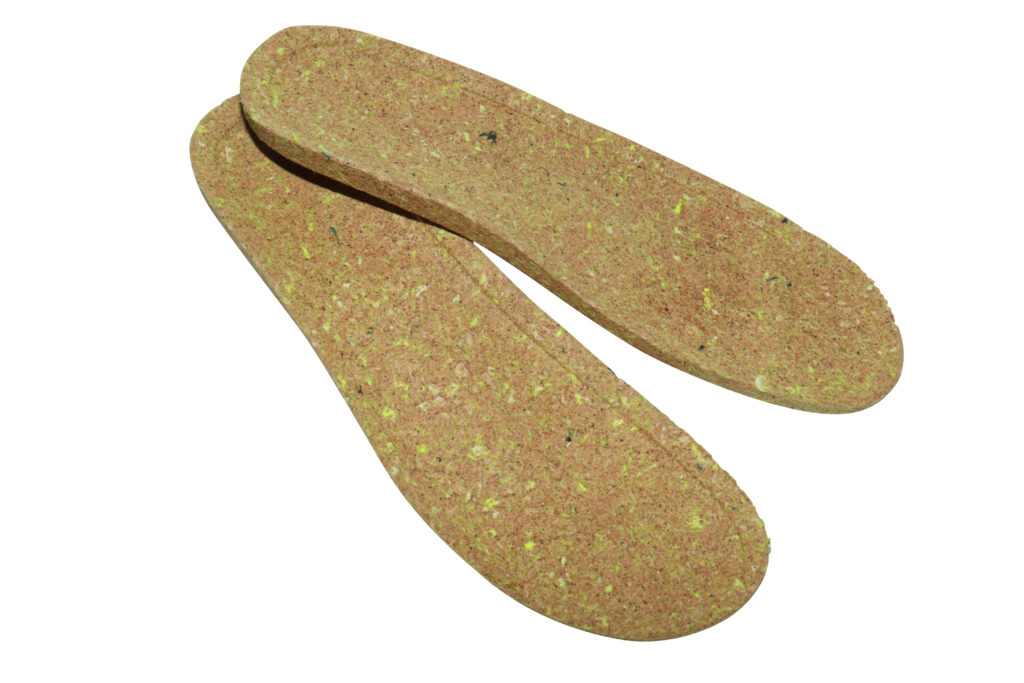
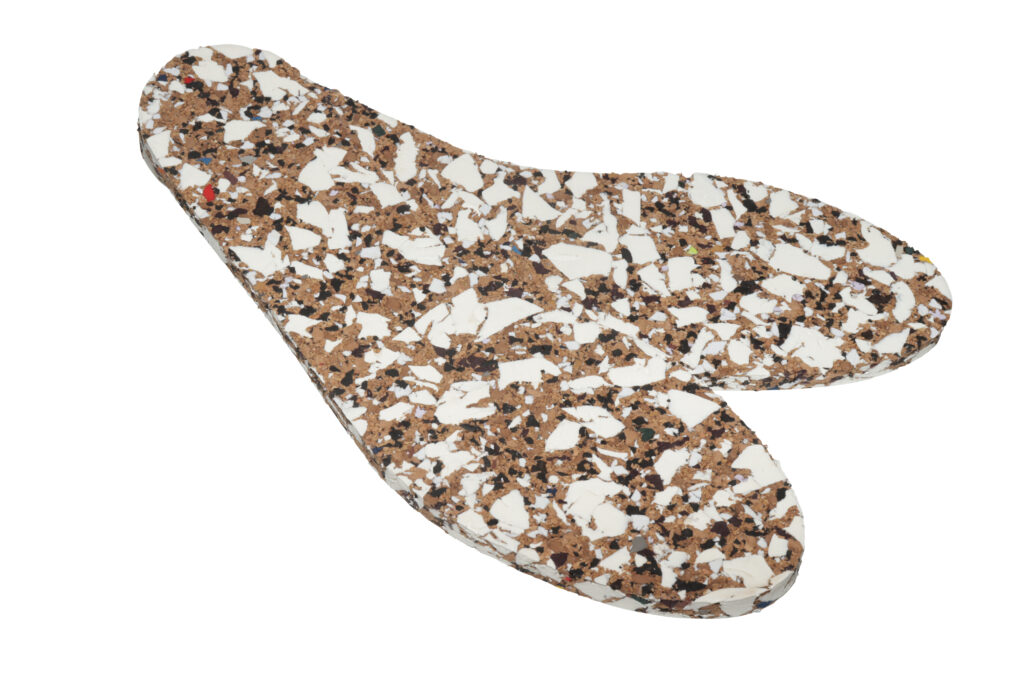
Photo credit: 3D CORK website
A very versatile material, cork, which 3D CORK‘has also managed to mix with other recycled products to further optimize the level of sustainability of its soles. Very interesting is the mix of cork with a mixture of chopped up old tennis balls, which also gives it a curious look.

ARNEPLANT, a Spanish company, uses a similar approach for one of its products, the Arneflex MAIZE. Again, it draws on nature, but from a different point of view. The insoles are made from corn foam. The new bio-based foam, in fact, is made from waste from the corn food industry. It uses organic corn polyol as the basis of the formulation and retains all the characteristics and benefits of traditional open-cell foams.
You may also be interested in the following articles:

Miguel Pomares (Ecoalf): how to make the difference in fashion universe
An interview with Miguel Pomares (Ecoalf)

Ecoalf: advanced technology for sustainable footwear production
How Ecoalf makes stylish and durable shoes with environmentally friendly technologies wages

The passion for shoes, evolving like technology
Shoes, technology and passion. The world of footwear, trends and latest evolutions.
CAUCHOS ARNEDO has also found a way to rely on nature to make soles consisting, in this case, of 100% natural rubber. The company is not only concerned with producing soles that once discarded can be safely recycled, but also that the extraction of the rubber is done only in forests with certified sustainable management, ensuring the health and biodiversity of the ecosystem, as well as fair treatment for workers.
Can milk soles be had? Apparently so. Don’t think about pastures, though; we’re always talking about plants here. The hevea tree hides a noble and valuable substance in its trunk: its milk. This milk is taken according to the tree’s natural production cycle, and after 25 years of exploitation, each tree is renewed. The purity of virgin hevea milk gives birth to a 100% natural and recyclable sole. Exclusive craftsmanship know-how allows the creation of the inimitable honeycomb structure, the result of the subtle alchemy between tradition and modernity.

The LACTAE HEVEA® sole does not use any animal products, by-products or derivatives. All soles are processed in France. The hevea milk is poured directly into the molds and refined for seven days. The purity of virgin milk and 100% artisanal care result in soles that require more than fifty manual operations to come to life. The inimitable honeycomb microstructure of the LACTAE HEVEA® sole, consisting of an infinite number of air cells, provides incredible cushioning.

The latest examples of sustainable soles, because they are made from natural materials, is provided by SELASTI with its Natural Side project.
I’m Green, is a line of soles made with BioBased™ E.V.A., a material with ethylene totally of biogenic origin.
Eva Bloom, on the other hand, is a material that employs at least 20% raw materials from algae, recovered from the oceans that produce excess due to the generalized rise in temperatures.
In the panorama of experiences that wants to make the sole of a shoe something that is not harmful to the environment, we also find another approach, one that focuses on recycling.
Consider FINPROJECT and its XL EXTRALIGHT® SUSTAINABLE+ soles. A new high-quality compound made by recycling 51% post-industrial production materials, avoiding disposal in landfills.
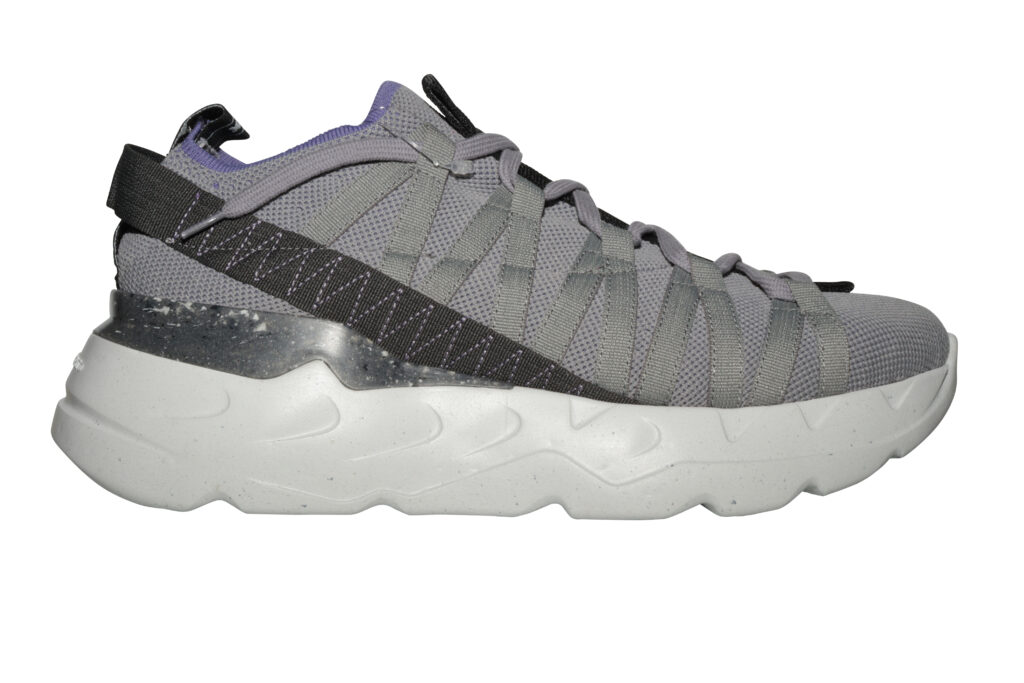
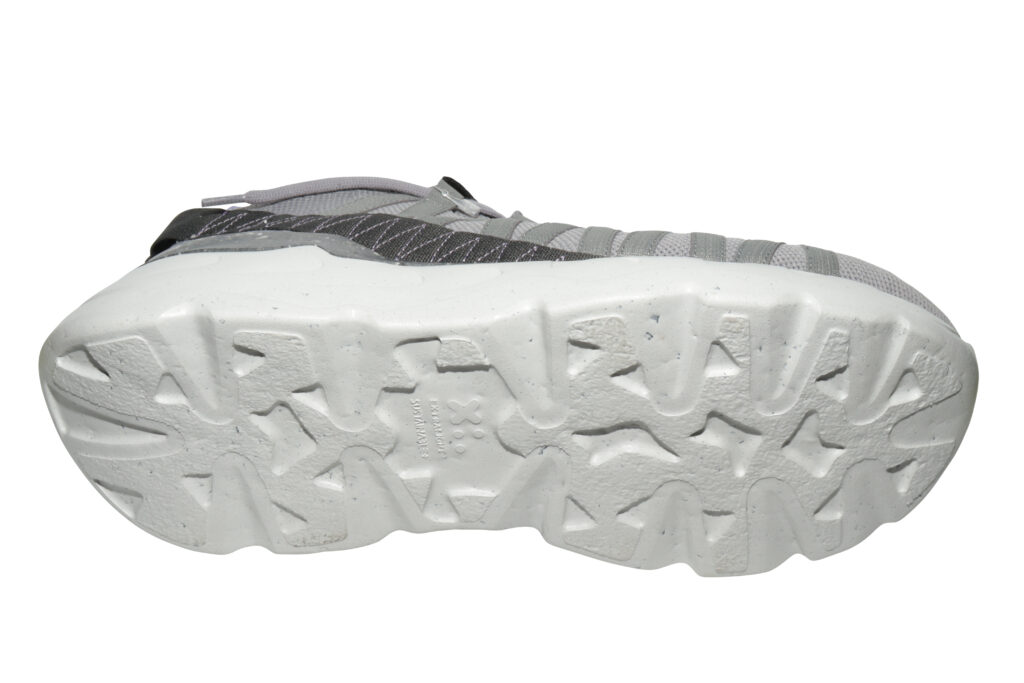
XL EXTRALIGHT® SUSTAINABLE+ soles are made from 51% recycled material (from FINPROJECT)
A lightweight, comfortable and durable compound produced using sustainable raw materials from renewable bio-naphtha derived from organic waste or by-products.
Just now we were talking about tennis balls. They bounce up to here and become part of the annealing processes of ISI SOLES, a company that takes into consideration the entire life cycle of the sole, designing an eco-friendly production process from raw materials to the production and transportation of the sole, to its use and subsequent disposal.
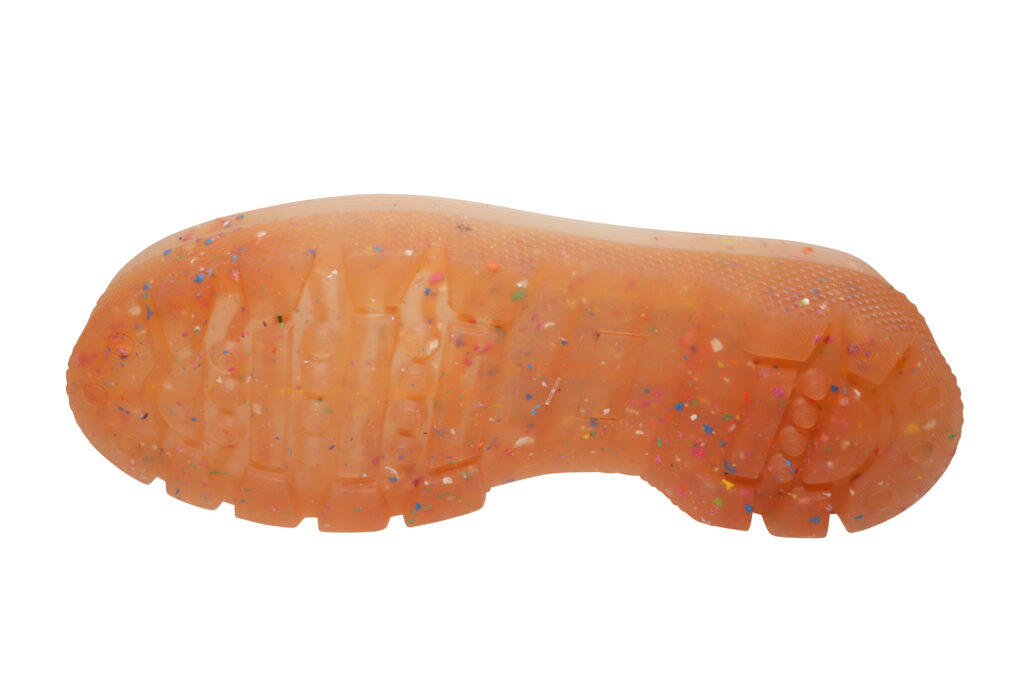
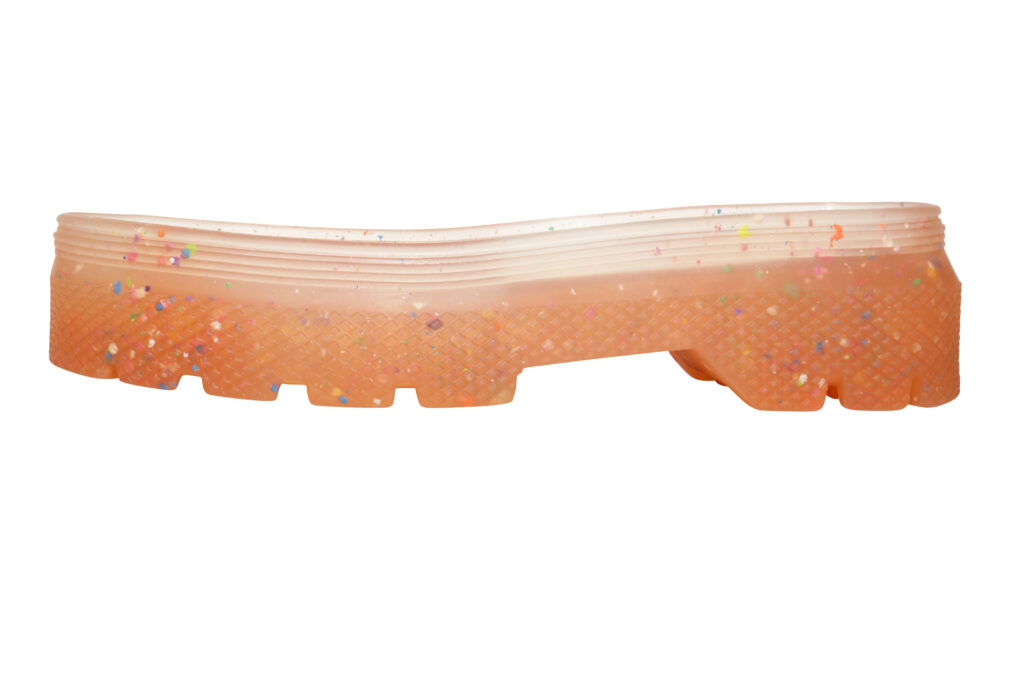
ISI SOLES, the company extending eco-friendliness throughout the value chain.
In terms of raw materials, ISI SOLES makes soles that incorporate shredded tennis balls into a thermoplastic rubber compound, as well as its own production waste. An RCS-certified product, the voluntary international standard that establishes requirements for third-party certification of recycled inputs and chain of custody.
Ready for a surprise? ISI SOLES also recycles defective party balloons, recovered directly from factory waste.
GOMMUS, a company from the Marche region of Italy, has been working on behalf of the planet with its Go!Zero brand: four different paths to reduce or zero waste generation, while respecting lightness and comfort. Go!Zero Return Rubber is a special rubber compound that degrades almost completely once it enters a composting environment. During use, the sole remains intact: it is, in fact, the bacterial environment of the landfill that makes it possible to activate the degradation process. From then on, the material begins to deteriorate, until it almost disappears after 180 days.

Go!Zero Recycle uses a minimum of 25 percent recycled material from its production waste. Go!Zero Reverse reverses the curing process, obtaining new raw material, similar to virgin material, from the waste. Go!Zero Remade is also made from materials recovered 20 percent from production waste.
We close by examining in more detail the world of women for whom, often, the word sole rhymes with heel. A technically advanced component: it must be beautiful, perfectly designed to match the ergonomics of the last, excellent in its engagement with the sole, and impeccable in its choice of materials, because it must be durable and reliable in supporting the weight of the whole body.

Despite all these requirements, heel manufacturers are also moving toward sustainability. This is being done by the VAL DI CHIENTI PLAST heel producer with its line Val Natural made from recycled or biodegradable materials (in 3 to 5 years). All Val Natural products are certified, traceable, and made with a high percentage of recyclable material, in line with the zero-waste principles of the circular economy.
TACCHIFICIO VILLA CORTESE has also used different approaches. Such as for the Fheelbio BCA™ line, which uses an ISCC+ certified bio-circular attribution material. The share of sustainable material derived from the sourcing of organic material waste (Bio-Circular-Attributed) is allocated through mass balance and tracked throughout the supply chain through chain-of-custody compliance.

Products made in Fheelbio BCA™ have identical performance, quality and properties compared to standard products and come with a Sustainability Statement attesting to sustainable content allocation. FheelGreen™, on the other hand, is an alternative material to traditional ABS that features excellent sustainability performance while maintaining mechanical and aesthetic properties. Camheelion™ is the customizable, environmentally friendly heel collection by 3M and Tacchificio Villa Cortese. The application of 3M films in the finishing of the heels makes it possible to decrease environmental impact through the use of innovative materials and the reduction of production waste.
It is still too early to imagine a sole or a heel walking into a phone booth, tearing off their shirt, and with an ‘S’ on their tread flying into the sky to save the world, but it is comforting to know that the entire footwear industry, starting with the soles, is moving to build a more acceptable and less violent future for the planet in this sector as well.












































